Mid-early dessert variety of honeysuckle “Volshebnitsa”
The sorceress is a young but promising curative. Gardeners often prefer it because it bears fruit consistently, is unpretentious and frost-resistant, which is especially important for residents of Siberia and the Urals. We will talk about the features of growing a Sorceress, its advantages and disadvantages.
Description of the honeysuckle variety Sorceress
This variety is the result of the work of domestic breeders. The berries have a rich chemical composition and a sweet and sour taste, suitable for fresh consumption and processing.
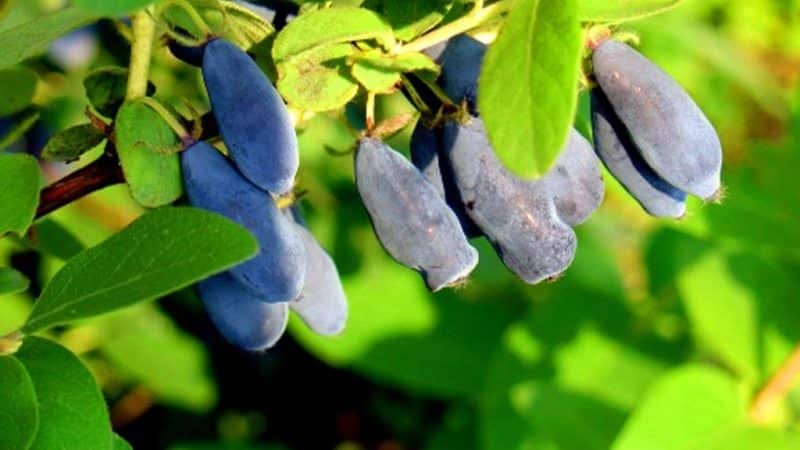
Origin and development
The sorceress was bred by breeders of the South Ural Research Institute of Horticulture and Potato Growing by free pollination of a seedling of Kamchatka honeysuckle Smolinka.
The variety has been under state variety testing since 1993. It was included in the State Register of Russia in 2000.
Characteristics, description of appearance, taste
The plant is a medium-sized bush 1.3-1.5 m high. The shoots are brown-red, thick and erect, covered with a waxy coating. The leaves are medium in size, elongated oval in shape, smooth, slightly concave along the central vein.
The berries are large, reach a length of 2.5 cm or more, weigh 1-1.3 g. The weight of some specimens reaches 1.5 g. The fruits are pear-shaped or ellipsoidal, covered with a thin dark blue skin, on which there is a dense waxy coating.
The pulp is tender and juicy. It has a pleasant aroma and sweet and sour taste, in which astringency and sometimes bitterness are felt.
Features of application
The berries are consumed fresh, frozen, dried, dried, ground with sugar, canned after making jam, marmalade or compote. The fruits are suitable for squeezing juice and preparing alcoholic beverages - wine, liqueur, liqueur.
In folk medicine, the entire aerial part of honeysuckle is used, preparing infusions and decoctions from it.
Ripening period, yield and fruiting
Sorceress is an early ripening honeysuckle variety. The period for the onset of biological maturity of fruits depends on the growing region. So, in central Russia, the crop is ready for harvesting at the end of June - mid-July.
With proper care, 1.8-3 kg of berries are harvested from an adult (4-6 years old) bush. The average yield is 40.6 c/ha.
Reference. Fruiting is impossible without pollinating varieties.
Resistance to diseases and pests
The variety is resistant to many pests, fungal and infectious diseases. However, if not properly cared for, it can be affected by: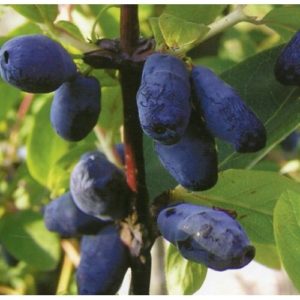
- ramulariasis;
- cercospora;
- tubercularosis;
- powdery mildew;
- aphid;
- scale insects and false scale insects;
- mites;
- leaf roller, moth and other caterpillars.
Resistance to cold and drought
The variety is frost-resistant: adult bushes can tolerate air temperatures down to -40°C, but flower buds die from cold even at -5°C.
Lack of moisture does not affect the growth, development and productivity of the Sorceress, but causes the appearance of bitterness and astringency in the taste of the berries and their premature shedding.
Growing regions and climate requirements
The variety does not impose special requirements on climatic conditions and soil composition, so it is successfully cultivated in all regions.
Advantages and disadvantages
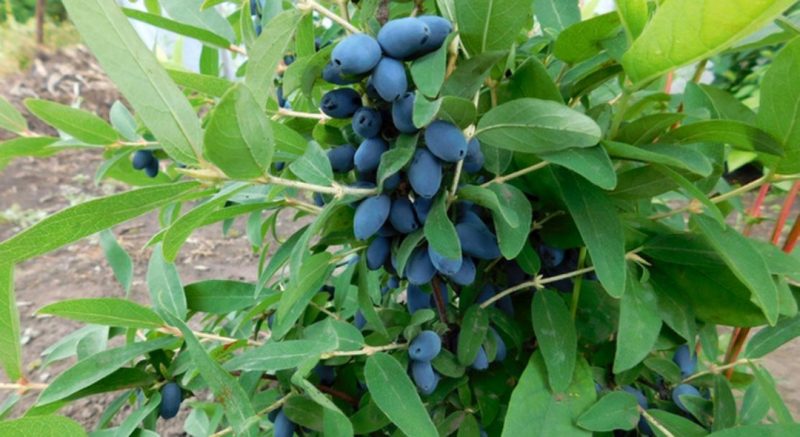
Benefits of the Sorceress:
- large fruit;
- good commercial quality;
- high content of vitamins and minerals;
- possibility of universal use;
- relatively good shelf life and transportability;
- lack of tendency to shedding;
- unpretentiousness;
- drought and frost resistance;
- good immunity.
Disadvantages of the variety:
- need for pollinators;
- low yield;
- prone to pest damage;
- presence of bitterness in taste.
Difference from other varieties and hybrids
A comparison of the Sorceress with other early ripening varieties is presented in the table:
| Variety | Ripening period | Average weight of berries, g | Taste | Berries shape | Productivity, c/ha |
|---|---|---|---|---|---|
| Enchantress | Early | 1-1,3 | Sweet and sour | Pear-shaped or ellipsoid | 40,6 |
| Cinderella | Early | 1-1,4 | Sweet with sourness | Oval-elongated, elongated or fusiform | 10,5 |
| Amazon | Early | 1,1 | Sweet and sour | Pitcher-shaped | 45,1 |
| Berel | Early | 0,45 | Sweet and sour with bitterness | Conical | 76 |
Agricultural technology
In order for the bushes to grow and develop, it is important to comply with the agrotechnical requirements of the crop and choose the right place and time for planting the seedlings.
Choosing a place in the garden and preparing holes
Honeysuckle planted in an open, well-lit area. Groundwater must lie at a minimum of 100 m and a maximum of 150 m from the ground surface.
Reference. Shrubs can grow and develop in partial shade, but in this case their productivity decreases.
Preparing for landing
For planting, one- or two-year-old seedlings 40 cm high with 2-3 shoots are used. If the root system of the plant is open at the time of purchase, it is easier to verify its viability. But the earthen ball protects the roots from mechanical damage and drying out.
To improve rooting, seedlings are soaked for several hours in a solution of a growth stimulator (Heteroauxin, Kornevin, Epin).
Reference. Any inclusions, uneven coloring of the bark or root shoots are signs of plant disease.
Soil requirements
The sorceress prefers fertile soil with good moisture permeability, aeration and a neutral acidity level. Allowed cultivation varieties in alumina or sandstone, but during planting peat or sand is added to clay soil, and humus is added to sandy soil.
Dates, scheme and rules of planting
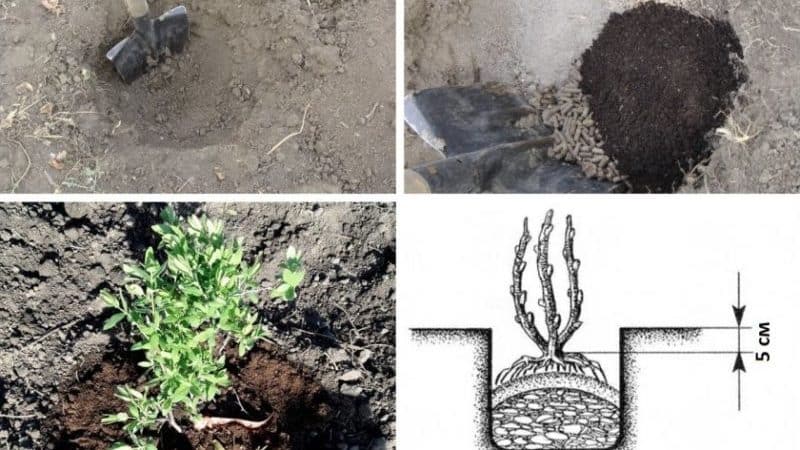
Honeysuckle is planted in early spring (March) or mid-autumn (October), before or after active sap flow.
Landing scheme and rules:
- Dig planting holes measuring 40x40 cm in the prepared area at a distance of 150-200 cm from each other.
- Throw away the bottom layer of the extracted soil, and mix the top layer with compost or humus (10-15 kg), superphosphate (50-60 g) and wood ash (2 tbsp).
- Fill the bottom of the planting holes with soil enriched with fertilizers and a layer of drainage.
- Straighten the roots of the seedling and place it in the center of the hole.
- Fill the voids with soil.
- Compact, water and mulch the top layer.
- After the soil settles, leave the root collar above the surface or deepen it 3 cm.
The holes are prepared at least 3 days before planting the seedlings.
Nuances of care
The best predecessors of honeysuckle are eggplants, cucumbers, tomatoes, potatoes, pumpkins, peppers, watermelon, radishes, zucchini or meadow grasses. The crop is not planted after currants, gooseberries and other varieties of honeysuckle.
In the northern regions, bushes are watered 2-3 times per season: during flowering and fruit set, after harvesting and at the end of autumn. Water consumption in this case is 10-15 liters per 1 bush. Increase the frequency of watering when growing Sorceresses in warm areas or in case of abnormally hot summers.
Watering is stopped 2-3 weeks before harvest. Otherwise, the keeping quality and quality of the fruit deteriorate.
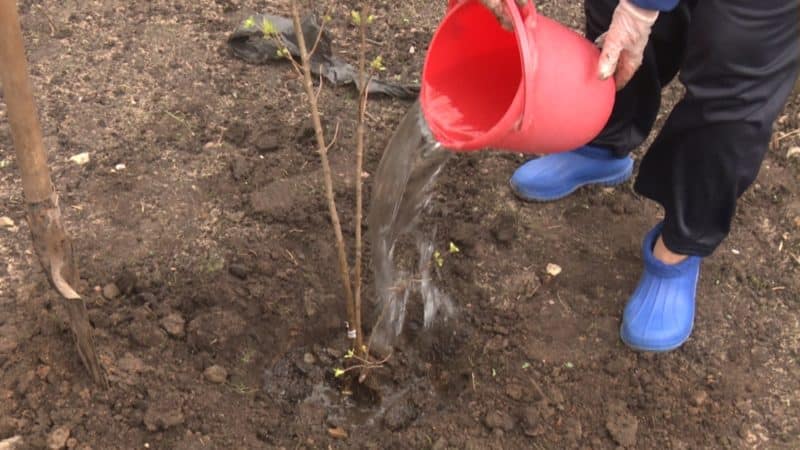
Important! When watering, water is poured along the edge of the tree trunk circle, having dug a trench in advance. The sprinkling method provokes the development of diseases.
The bushes begin to be fed from 3 years after planting, applying fertilizers according to the following scheme:
- early spring - ammonium nitrate or urea (15 g per 1 m²);
- budding and flowering - double superphosphate (40 g per 1 m²) and potassium sulfate (20 g per 1 m²);
- after harvesting - “Nitroammofoska” or “Nitrophoska” (25-30 g per 1 m²);
- for digging - compost (5 kg per 1 m²).
After watering or rain, the soil is loosened to improve the access of oxygen and moisture to the roots, and weeded.
In spring and autumn, sanitary and anti-aging pruning is carried out. It involves removing old, diseased and damaged branches, interfering shoots and numerous root shoots. From time to time, strong skeletal branches are shortened by a third - this stimulates their growth.
Pollinators
Sorceress is a cross-pollinated variety, so pollinating varieties are planted nearby to set fruit:
- Long-fruited;
- Chelyabinsk;
- Smolinka;
- Zest;
- Blueberry;
- Sineglazka.
Disease and pest control
Possible diseases and pests of the variety:
| Disease/pest | Signs | What to process |
|---|---|---|
| Ramulariasis | In early spring, gray-white spots appear on young leaves, which darken, enlarge and lose shape over time. | Copper sulfate solution with added soap |
| Cercospora | Brown marks with a red edge form on the leaf blades, and soon the leaves dry out and die. | "Fundazol" |
| Tuberculariosis | Red bumps form on the branches and bark, spreading to other shoots, which can cause the death of the bush. | Copper-containing fungicides: Bordeaux mixture, copper oxychloride |
| Powdery mildew | Powdery white spots appear on the foliage. | Sulfur-containing preparations “Zineb”, “Tiovit Jet”, “Cumulus” |
| Aphid | Insects suck the juices from the shoots, and the plant withers. | "Biotlin" |
| Scale insects and false scale insects | The shoots wither and the plant weakens. | "Aktellik", "Rogor" |
| Ticks | Leaves wither and curl. | Colloidal sulfur, "Confidor" |
| Leaf rollers, moths and other caterpillars | The leaves curl up and a cobweb appears on them. | "Iskra", "Inta-Vir" |
Scheme for treating bushes to prevent diseases and pest attacks:
- swelling of the kidneys - urea, Bordeaux mixture or copper sulfate;
- before flowering - “Biotlin” or “Calypso”;
- after flowering - biological products “Trichodermin”, “Fitosporin”.
Preparing for winter
Sorceress is a frost-resistant variety; the bushes do not need winter shelter even when grown in Siberia and the Urals.
Preparing plants for cold weather:
- clear the ground around the bushes from plant debris;
- pour plenty of settled water;
- shallowly (about 10 cm) dig up the tree trunk area and apply organic fertilizers;
- treat the above-ground part of the bush with copper sulfate to increase its immunity.
Reproduction
Growing honeysuckle from seeds takes a lot of time, so most often the Sorceress is propagated vegetatively - by layering or dividing the bush.
To root the cuttings, they dig up the bush in June, select a strong shoot located at the bottom of the outside of the bush, bend it to the ground, secure it and dig it in so that the top remains above the surface of the ground.Within 2-3 months, this shoot is watered abundantly, and after a year it forms an independent root system, after which it is separated from the mother bush with pruning shears and transplanted to a permanent place.
During transplantation, the method of dividing the bush is used. To do this, the plant is dug up and divided into several parts with a sharp knife so that each has the same number of shoots. For better rooting, before planting in the ground, the cuttings are kept in a solution of a growth stimulator (Kornevin, Epin).
Important! The method of dividing the bush is not used for plants older than 7 years.
If after rejuvenating trimmings healthy shoots remain, they are placed in a mixture of garden soil and sand or peat, covered with film, regularly watered, ventilated and wait for sprouts to appear.
Difficulties in growing
Difficulties in cultivating a Sorceress:
- low yield - bushes grow in the shade;
- the taste of the berries has a pronounced bitterness - lack of moisture;
- the plants are weakening, the leaves and shoots are withering - the bushes have been attacked by pests.
Harvesting
In the middle zone, the harvest is harvested at the end of June - mid-July within 5-6 days after the berries ripen.
Honeysuckle is stored in the refrigerator for a maximum of 2-3 days. After this, it loses its freshness and releases juice.
Tips and reviews from experienced gardeners about the variety
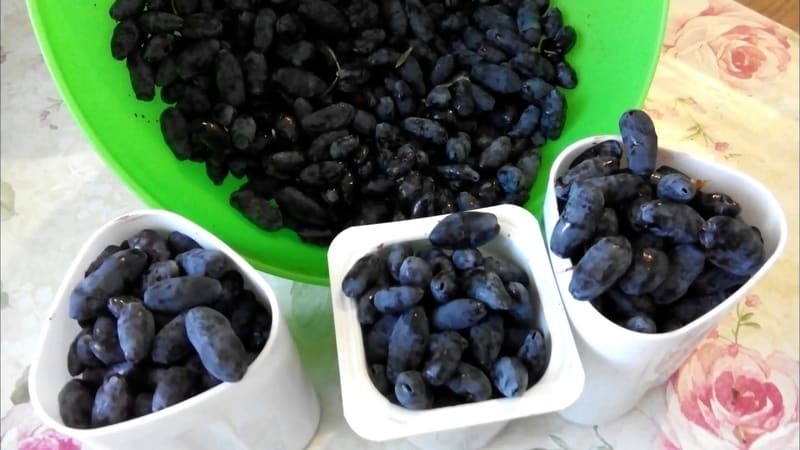
Experienced gardeners recommend:
- Use several varieties of pollinators. If one variety does not bloom due to unfavorable weather conditions, pollination will be provided by others.
- Plant bushes along a fence or buildings - this way drafts and wind will not damage the seedlings.
Farmers speak positively about the Sorceress:
Oksana. Severodvinsk: “I really love honeysuckle, so I planted several seedlings on my site.Of all the varieties, I chose the Sorceress because it is unpretentious, frost-resistant and bears fruit consistently. I also like the fact that the berries are delicious both fresh and canned.”
Alexey, Orenburg: “I bought and planted the Sorceress seedlings about 6 years ago. The variety turned out to be frost-resistant and unpretentious, although the bushes began to bear fruit only 4 years after planting. The berries are large, sweet and sour, and make very tasty jam. The only downside I’ll note is the need for pollinators.”
Conclusion
Edible honeysuckle Sorceress is suitable for growing on personal plots and large areas for sale. Minor disadvantages - the need for pollinators and relatively low yield - are compensated by a lot of advantages of the variety: unpretentiousness, drought and frost resistance, large fruit, lack of tendency to shed and good immunity.